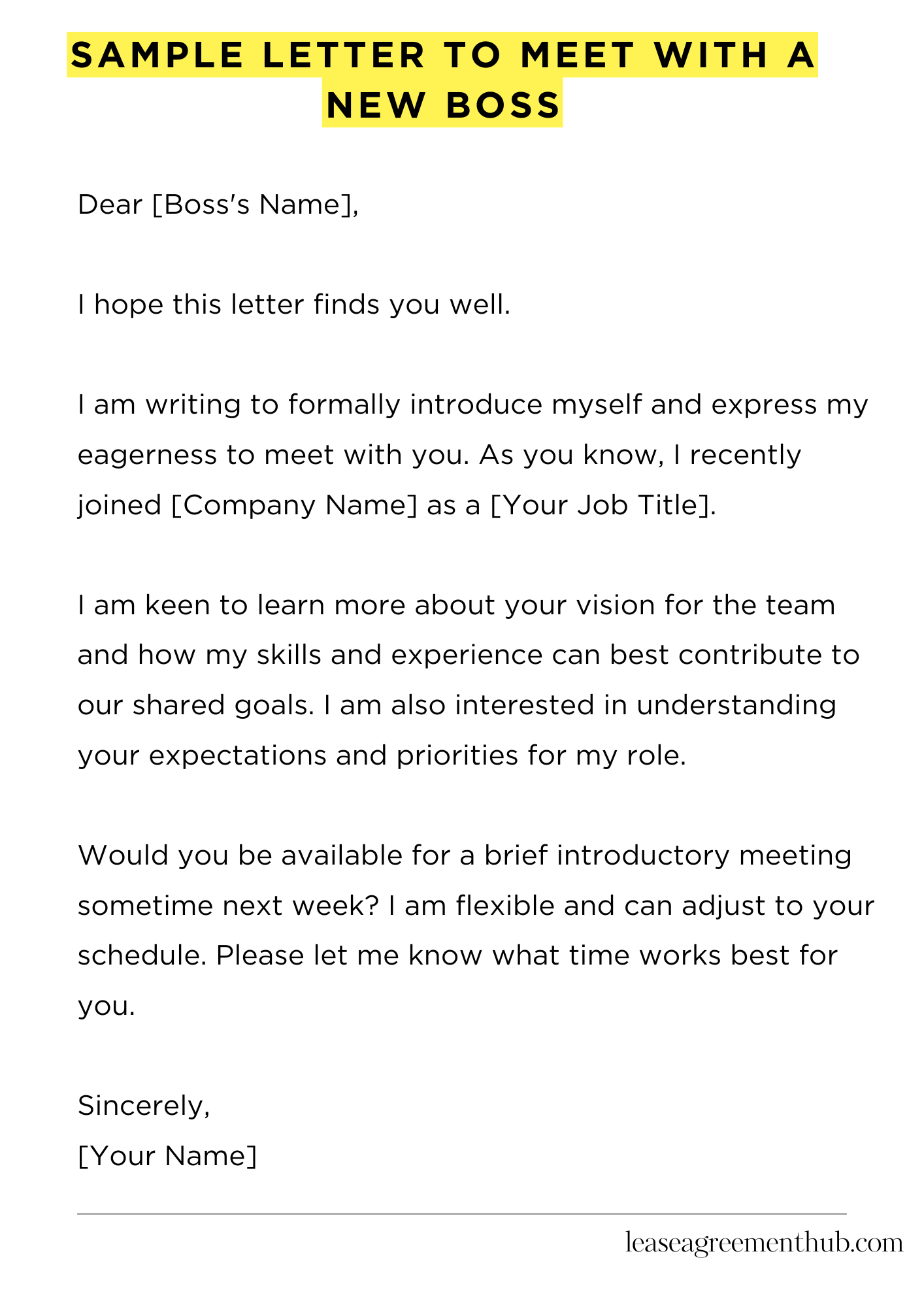A “Sample Letter To Meet With a New Boss” is simply a written request. You use it to schedule an initial meeting. This is common when a new manager joins your team. It helps you introduce yourself and your role.
Want to make a great first impression? We have you covered. This article provides letter templates. These samples will help you craft the perfect email.
We aim to simplify your communication. Use our examples as a guide. Easily adapt them to your unique situation. Start building a strong relationship with your new boss today.
Sample Letter To Meet With A New Boss
[Your Name]
[Your Address]
[Your Phone Number]
[Your Email Address]
[Date]
[Boss’s Name]
[Boss’s Title]
[Company Name]
[Company Address]
Dear [Boss’s Name],
I hope this letter finds you well.
I am writing to formally introduce myself and express my eagerness to meet with you. As you know, I recently joined [Company Name] as a [Your Job Title].
I am keen to learn more about your vision for the team and how my skills and experience can best contribute to our shared goals. I am also interested in understanding your expectations and priorities for my role.
Would you be available for a brief introductory meeting sometime next week? I am flexible and can adjust to your schedule. Please let me know what time works best for you.
Thank you for your time and consideration. I look forward to our meeting.
Sincerely,
[Your Name]

How to Write a Letter to Meet With a New Boss
Crafting a Compelling Subject Line
- Keep it concise and germane. A subject line such as “Introduction Request – [Your Name]” is often effective.
- Avoid ambiguity; your new boss should immediately understand the purpose of the email.
The Initial Salutation: Striking the Right Chord
- Address your new superior formally: “Dear Mr./Ms./Dr. [Last Name],”
- Avoid overly casual greetings until a rapport is established. Professionalism is paramount.
The Introductory Paragraph: Forge a Connection
- Briefly introduce yourself and your role within the company.
- Express enthusiasm about working with your new leader and the team. A touch of legitimate excitement can be disarming and appreciated.
Articulating Your Purpose: The Core of Your Missive
- Clearly state your intention: to schedule a brief introductory meeting.
- Highlight the benefit of this meeting. For example, “to better understand your vision for the team” or “to discuss how I can best contribute to our shared objectives.”
Suggesting Availability: Facilitating a Response
- Offer a few specific dates and times that work for you. This demonstrates initiative and respect for their schedule.
- Indicate your flexibility. “I am also available at other times that may be more convenient for you.”
Highlighting Value: A Subtle Persuasion
- Mention a pertinent skill or experience that aligns with the team’s goals. This isn’t about boasting; it’s about demonstrating potential value.
- Keep it succinct and relevant. One or two sentences should suffice.
The Closing: A Graceful Denouement
- Use a professional closing such as “Sincerely,” or “Best regards,” followed by your full name.
- Include your contact information (phone number and email) for ease of response.
Frequently Asked Questions: Meeting Your New Boss
Preparing for your initial meeting with a new manager is crucial for establishing a positive and productive working relationship. This FAQ section addresses common inquiries to help you navigate this important interaction effectively.
1. What is the primary goal of sending a letter to request a meeting with my new boss?
The primary goal is to proactively introduce yourself, express your enthusiasm for the role, and schedule a convenient time to discuss your responsibilities and the team’s objectives.
2. What key information should I include in my introductory letter?
Include a brief introduction of yourself, your role and responsibilities, your enthusiasm for joining the team, and a suggestion for scheduling a meeting at their earliest convenience.
3. How soon after my start date should I send the meeting request letter?
Ideally, send the letter within the first few days of your employment. This demonstrates initiative and eagerness to understand your role and contribute to the team’s success.
4. What tone should I adopt in my letter to my new boss?
Maintain a professional, respectful, and enthusiastic tone. Express your eagerness to learn and contribute to the company’s goals.
5. What should I do if I don’t receive a response to my initial letter?
If you don’t hear back within a reasonable timeframe (e.g., 3-5 business days), send a polite follow-up email or, if appropriate, reach out via phone. Be mindful of their schedule and communication preferences.
Related: